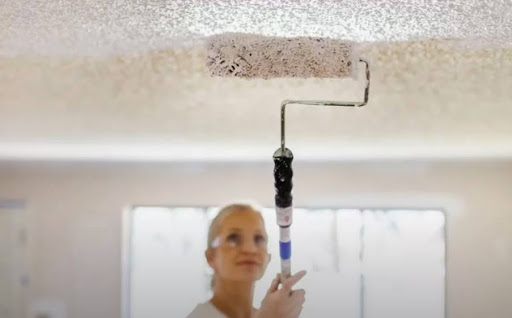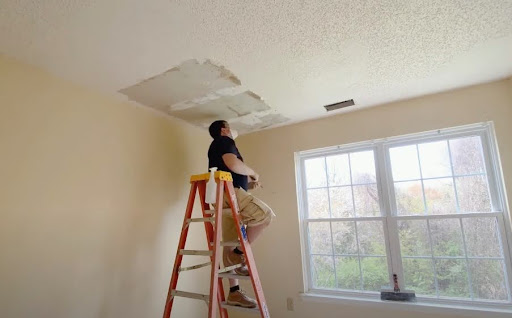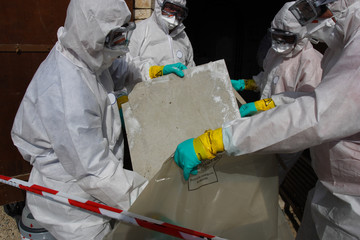As you gaze up at the lumpy, cottage cheese-like texture of your ceiling, are you concerned about the safety of your home? The use of popcorn ceilings was widespread in the past and often contained asbestos. This guide is to offer crucial insights and useful tips on how to address worries related to asbestos found in textured ceilings.
What are Textured Ceilings?

Popcorn ceilings, also called textured ceilings, are a form of surface enhancement administered to the ceiling space within a room. This method requires coating with an uneven texture that usually imitates bumpy or popcorn-like features on the ceiling’s exterior layer. The fundamental objectives for using Textured Ceilings include:
- Hiding Flaws: Textured ceilings were initially designed to conceal any blemishes or unevenness present on the ceiling’s surface, resulting in a flawless and consistent look.
- Sound Insulation: The ceiling texture aids in sound insulation by absorbing and scattering sound waves, effectively reducing the transmission of noise between rooms.
- Aesthetic Appeal: Textured ceilings were visually attractive at their peak because they contributed depth and personality to the overall design of a room.
The Asbestos Concern
Textured ceilings, particularly those installed from the 1950s to the 1980s, pose a significant concern due to their potential asbestos content. Asbestos is a natural mineral made up of long and thin fibers that have advantageous characteristics such as fire resistance, insulation properties, and lasting durability; hence it was widely used in construction materials at one time. Nonetheless, exposure to these fibers can lead to severe health issues including cancer and lung conditions. Here are some important facts about asbestos presence within textured ceilings:
- Asbestos in Popcorn Ceilings: During the mid-20th century, a number of popcorn ceilings were installed with asbestos fibers for their fire-resistant properties. This was a widely adopted practice at that time.
- Health Risks: Asbestos fibers are extremely dangerous for human health if inhaled. Symptoms of asbestosis, lung cancer, and mesothelioma, which are linked to this substance, may not manifest for many years after exposure.
- Disturbance Risks: The peril of asbestos contained in textured ceilings is brought to light when any sort of disruption occurs, such as during reconstruction or elimination. Such disturbances have the ability to discharge asbestos particles into the atmosphere which may be inadvertently breathed in by individuals present and consequently create a potential health hazard.
Identifying Asbestos in Popcorn Ceilings
Identifying the presence of asbestos in textured ceilings based solely on appearance can be difficult. This challenge is particularly pronounced for homes constructed before 1980, which commonly contain asbestos. The most conclusive way to confirm its presence is through professional sampling and analysis at a laboratory facility. For detailed guidance on identifying asbestos specifically in popcorn ceilings, follow these steps:
Signs of Asbestos in Popcorn Ceilings
Although asbestos cannot be positively identified through visual inspection alone, there are various indicators that suggest its existence.
- Age of the Building: Buildings built before 1980 are more likely to harbor asbestos as it was frequently incorporated into construction materials prior to regulations that curtailed its usage.
- Texture Appearance: The visual appearance of asbestos-containing popcorn ceilings may feature a bumpy, gritty or uneven texture in contrast to contemporary textures. Nevertheless, this perception alone cannot confirm its presence.
- Vermiculite Insulation: There is a possibility that vermiculite insulation contains asbestos. Insulation made of vermiculite and popcorn ceilings were common in older homes.
- Professional Assessment: The most dependable way to detect asbestos in popcorn ceilings is by enlisting the services of a certified inspector or abatement expert who can perform sampling and analysis as part of their professional assessment.
Professional Sampling and Laboratory Analysis
Following these steps is crucial for conclusively identifying asbestos in popcorn ceilings:
- Find a Certified Professional: Search for a Certified Professional: Find an asbestos inspector or abatement professional who is certified, equipped with the necessary expertise and tools to conduct testing.
- Sample Collection: During the sample collection process, precautions will be taken by the professional to minimize any asbestos fibers from being released into the air while carefully collecting samples from your popcorn ceiling.
- Laboratory Analysis: The gathered specimens are dispatched to a certified laboratory that specializes in asbestos examination. Utilizing specialized methods including polarized light microscopy (PLM) or transmission electron microscopy (TEM), the experts will determine the presence of asbestos fibers.
- Results and Recommendations: Upon completion of the analysis, a comprehensive report outlining any possible asbestos presence will be furnished by the laboratory. In case of an affirmative detection, detailed information regarding concentration and variety shall also be specified in said report for reference. The professional certified personnel utilizing this collected data would then prescribe appropriate measures like encapsulation or removal as deemed necessary depending upon current conditions.
Safe Handling of Textured Ceilings Asbestos

In the past, asbestos was a popular mineral used in construction materials because it possessed fire-resistant capabilities. If you believe your textured ceiling contains asbestos, taking extreme precautions is imperative. Disturbing such ceilings could result in hazardous airborne fibers and cause grave health hazards when breathed in. This comprehensive manual will provide you with precise guidelines to ensure the safe handling of textured ceilings that carry traces of asbestos.
Do Not Disturb
To prevent the release of asbestos fibers into the air, it’s crucial to refrain from tampering with a textured ceiling that may contain this hazardous material. If you have concerns about its presence, follow these essential safety measures:
- Avoid scraping, sanding, drilling or any other activity that may harm the ceiling.
- Refrain from performing activities that may produce dust or debris, such as using a hammer or cutting.
- Do not attempt DIY repairs or removal without professional guidance.
Professional Testing
Contacting an accredited asbestos professional is crucial to determine if your textured ceiling contains asbestos. This specialist will conduct a rigorous assessment of the presence and condition of asbestos through meticulous steps in professional testing, which include:
- Sampling: The professional will extract a piece of textured ceiling material for sampling.
- Analysis: The sample that has been gathered shall be sent to an authorized laboratory for asbestos confirmation analysis.
Consider the Options
If your textured ceiling has asbestos, the experts may suggest two main alternatives: either encapsulation or removal.
- Encapsulation: TThe process of encapsulation aims at sealing asbestos fibers to avoid their release into the atmosphere. To achieve this, a distinctive material is applied over the textured ceiling to form an impenetrable layer for protection purposes.
- Removal: Elimination of asbestos-containing materials is typically the favored method. This procedure entails cautiously removing the textured ceiling material to eliminate any potential risks linked with exposure to asbestos.
The Removal Process
If asbestos removal is deemed necessary, it’s crucial to hire trained experts who specialize in asbestos abatement. The removal process is intricate and requires meticulous execution to ensure safety. Here is an overview of the steps involved:
Hiring Professionals
Engage a certified asbestos removal contractor or firm with experienced professionals. Ensure they possess the necessary permits and licenses to carry out asbestos abatement.
Preparation
Before commencing the removal process, the professionals will take several precautions:
- Isolation: The work area will be isolated from the rest of the building to prevent asbestos fibers from spreading.
- Protective Gear: Removal specialists will wear protective suits, masks, and gloves to minimize their exposure to asbestos.
- Air Filtration: High-efficiency particulate air (HEPA) filtration systems will be set up to control air quality and capture any released fibers.
Removal
During the removal phase, experts will employ specific techniques to minimize the release of asbestos fibers:
- Wetting: Asbestos-containing materials will be wetted with a controlled mist of water to suppress dust.
- Gentle Removal: Specialists will carefully and systematically remove the textured ceiling material, ensuring minimal disturbance.
Clean-up and Disposal
After the removal, thorough clean-up and disposal procedures are crucial to prevent any residual asbestos contamination:
- Vacuuming: HEPA-filtered vacuum cleaners will be used to clean surfaces and air.
- Wipe Down: Surfaces will be wiped down with damp cloths to capture any remaining asbestos dust.
- Disposal: The asbestos waste will be sealed in leak-tight containers and disposed of in accordance with local, state, and federal regulations.
Alternatives to Removal
While removal is often the preferred method, there are alternatives that can be considered. Let’s explore two main alternatives:
Encapsulation
Encapsulation involves applying a sealant or coating to the textured ceiling to prevent the release of asbestos fibers. This sealant forms a protective barrier, keeping asbestos fibers contained within the ceiling material.
| Advantages | Disadvantages |
| Cost-effective compared to complete removal. | Not suitable for severely damaged or deteriorated ceilings. |
| Minimizes the risk of asbestos exposure. | Requires periodic inspection and maintenance. |
| Preserves the existing ceiling structure. | The encapsulant may degrade over time. |
| Requires less time and labor. | – |
Overboarding
Overboarding, also known as overcladding, involves installing a new ceiling directly over the existing asbestos-containing textured ceiling. This method creates a new, safe surface while encapsulating the asbestos-containing material beneath.
| Advantages | Disadvantages |
| Effectively covers asbestos-containing material. | Reduces ceiling height slightly. |
| Provides a fresh, clean appearance. | May not be suitable for spaces with limited headroom. |
| Can improve insulation and soundproofing. | Requires professional installation for best results. |
| Minimal disturbance to the existing ceiling. | – |
Preventive Measures
Before considering any alternative to removal or initiating maintenance and repair work, it’s crucial to adopt preventive measures to minimize the risks associated with asbestos-containing textured ceilings.
Regular Inspection
Regularly inspect textured ceilings for signs of damage, deterioration, or water leaks. Be vigilant for cracks, discoloration, or areas where the texture may have come loose. Early detection can help prevent further damage and potential asbestos fiber release.
Avoid Disturbance
Avoid drilling, cutting, scraping, or any activity that may disturb the textured ceiling. Such activities can release asbestos fibers into the air, posing health risks. Educate yourself and others working in the area about the potential dangers associated with asbestos-containing materials.
Education
Educate yourself and others about the potential risks and proper handling of asbestos-containing materials. Training and awareness are essential to ensure safety when dealing with such materials.
Maintenance and Repair
When maintenance or repair work is necessary for asbestos-containing textured ceilings, it’s essential to follow best practices to minimize the release of asbestos fibers.
- Wetting: Always wet the area before any work to minimize dust. Wetting the textured ceiling helps prevent the release of asbestos fibers into the air during the maintenance or repair process.
- Prompt Repairs: Seal any cracks or damage promptly to prevent further deterioration. Quick action can help contain asbestos fibers and prevent their release.
- Consider Drywall: Consider covering the entire asbestos-containing textured ceiling with drywall for long-term safety. This approach encapsulates the asbestos material, providing an additional layer of protection and a smooth, aesthetically pleasing surface.
Conclusion
Textured ceilings asbestos concerns are valid and should be addressed promptly to ensure the safety of your home environment. With the right knowledge and professionals on your side, you can navigate these concerns effectively. Regular inspection, prompt action, and professional guidance are key to managing the risks associated with asbestos in popcorn ceilings.
Remember, while the charm of a textured ceiling might be alluring, the safety of your home and health is paramount. By understanding and addressing the risks associated with textured ceilings asbestos, you can enjoy a safe and worry-free home environment.
FAQs
How common is asbestos in popcorn ceilings?
Common in homes built or remodeled before 1980.
Are all popcorn ceilings dangerous?
Not all contain asbestos, but it’s best to assume they do until tested.
Can I remove textured ceilings asbestos myself?
It’s strongly recommended to hire certified professionals due to the health risks involved.
How much does it cost to remove textured ceilings asbestos?
Costs vary depending on the size and complexity of the job.
What should I do if I accidentally disturb my ceiling?
Leave the area immediately, avoid further disturbance, and consult a professional.




